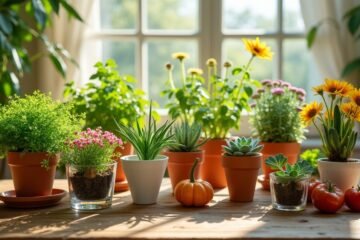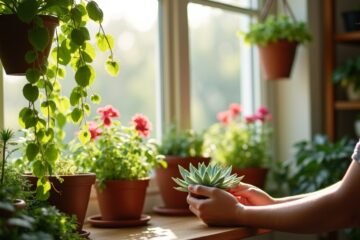Gardening with preschoolers is a blast! Think planting seeds in a colorful garden, where tiny hands dig and scatter vibrant seeds. Or create magical miniature fairy gardens with tiny plants and whimsical decorations that inspire storytelling! Don’t forget the sensory garden, bursting with fragrant herbs and colorful flowers. Explorations in soil can uncover hidden earthworms—so exciting! And what about harvesting those fresh veggies together? It’s pure joy! Stick around, and you’ll discover even more fun ideas!
Planting Seeds in a Colorful Garden

Imagine a vibrant garden bursting with colors, where tiny hands dig into the soil to plant seeds! You can spark your preschooler’s creativity by starting with some fun seed sorting. Gather seeds of various shapes and colors, and watch their eyes light up as they match them! It’s like a treasure hunt, but with nature’s goodies!
Once sorted, encourage them to plant each seed in its own little patch, creating a rainbow of possibilities. As they dig and plant, you’ll hear giggles and see smiles—what could be better? Plus, this hands-on activity helps develop their fine motor skills while they learn about nature. Who knew planting seeds could be this exciting? Get ready for a colorful adventure!
Creating Miniature Fairy Gardens

After planting seeds in your colorful garden, it’s time to let your imagination run wild with miniature fairy gardens! These tiny worlds, filled with whimsy, ignite your child’s creativity and spark imaginative play. Grab a shallow container and fill it with soil, then choose miniature plants, like moss or tiny succulents, to create a lush backdrop. Add charming elements—think pebble paths, tiny wooden houses, or even whimsical fairy figurines! You can use acorn caps as bowls or twigs as bridges. Encourage your little ones to invent stories about their fairy friends. What adventures do they have? Every time you glance at the fairy garden, it’ll remind you of magical tales and joyful moments spent together!
Designing a Sensory Garden

When you think about a sensory garden, picture a delightful space that awakens all five senses! Imagine sensory pathways made of colorful stones, guiding little feet through lush greenery. You’ll want to plant fragrant herbs like basil and mint, inviting curious noses to explore their aromatic delights. How about incorporating vibrant flowers that beckon with their bright colors? Create a soft spot for tiny hands to touch, like velvety lamb’s ear or spiky cactus. Don’t forget to add a water feature—maybe a small fountain?—to captivate those enthusiastic ears with gentle splashes. Every corner should spark excitement! Designing a sensory garden isn’t just about plants; it’s about crafting an experience that tickles imagination and fosters discovery. Ready to dig in?
Making Garden Markers With Nature

There’s something magical about turning everyday items into charming garden markers! Grab some smooth stones or popsicle sticks, and let your creativity flow. With your little ones, venture outside to collect leaves, flowers, and twigs. You can create nature impressions by pressing these treasures into clay or soft dough—how cool is that? For an artsy twist, make leaf rubbings using crayons and paper. Simply place the leaf under the paper, rub, and voilà! You’ve got a stunning design. Once you’ve crafted your markers, paint them with bright colors and label them with the plant names. Picture your garden bursting with personality, thanks to these whimsical markers! Who knew nature could inspire such delightful creations? Let’s dig in and get started!
Engaging in Soil Exploration Activities

Just like those colorful garden markers bring personality to your plants, exploring soil can uncover a world of wonder beneath our feet! Imagine digging your hands into rich, dark soil, feeling its texture between your fingers. Is it crumbly, sticky, or sandy? Each variety tells a unique story about the earth!
You can turn soil exploration into a treasure hunt! Invite your little ones to search for squiggly earthworms—nature’s very own recyclers! What a thrill to observe their wiggly dance as they burrow deeper!
With a magnifying glass, examine tiny critters or fascinating roots. Can you believe all the life hidden in just a handful of dirt? Soil exploration is an adventure waiting to happen, sparking curiosity and excitement at every turn!
Harvesting and Tasting Homegrown Vegetables

Imagine the thrill of pulling a plump, sun-kissed tomato right off the vine—it’s like finding hidden treasure in your own backyard! With your little ones, gather those vibrant vegetable varieties, from crunchy cucumbers to sweet peppers. Let the excitement bubble as you snip, twist, and pluck each one. Then, it’s time for the ultimate taste tests!
Set up a colorful spread with dips and toppings, and watch their eyes light up as they savor the flavors. “Is this cucumber sweeter than the last?” you’ll hear them ask, grinning from ear to ear. This hands-on experience teaches them about fresh food and encourages them to explore new tastes. Who knew gardening could be this deliciously fun?
Frequently Asked Questions
What Safety Precautions Should I Take During Gardening Activities With Preschoolers?
When you’re gardening, safety’s your best friend! First, don’t forget sun protection; slather on that sunscreen and rock those cute hats! As for tool handling, keep those sharp trowels and pruners away from tiny fingers. Instead, let them use kid-sized tools that spark joy and creativity! Remember, it’s all about fun and exploration, but a little caution goes a long way. Who knew gardening could be both thrilling and safe? Let’s dig in!
How Do I Choose Age-Appropriate Gardening Tools for Kids?
“Don’t put all your eggs in one basket!” When choosing kids’ tool types, opt for lightweight materials like plastic or bamboo, making it easy for tiny hands. Look for fun, colorful designs that spark excitement! Think about tools like mini shovels or trowels, which resemble their adult counterparts but are perfectly sized. Remember, safety’s key—rounded edges and smooth handles guarantee no accidental ouchies. With the right tools, your little ones will dig gardening!
What Are the Best Plants for Preschoolers to Grow?
When you’re choosing plants for little gardeners, think vibrant and lively! Easy herbs like basil and mint are perfect, filling the air with delicious scents. Colorful flowers like marigolds and sunflowers not only brighten your space but also attract butterflies! Imagine your kids giggling as they watch the tiny pollinators dance around. These plants are like nature’s confetti, creating a sensory explosion that’s both fun and educational. Ready to grow some green magic?
How Can I Incorporate Math Into Gardening Activities?
You can easily incorporate math into gardening! Start by measuring growth—how tall is that sunflower now? Grab a ruler and let the kids marvel at their green giants! Counting seeds is another fun way to engage them—how many beans fit in that tiny cup? It’s like a treasure hunt! Plus, they’ll learn about numbers while getting their hands dirty. Who knew math could be so much fun in the garden? Let’s dig in!
What Should I Do if My Child Loses Interest in Gardening?
When the gardening enthusiasm starts to wilt, it’s time to think outside the box! You can breathe new life into the experience with creative re-engagement strategies. How about spinning fun gardening games, like a treasure hunt for colorful seeds? Or, let your child design their mini garden patch, like a tiny masterpiece! Engaging their imagination can sprinkle excitement back into the dirt. Remember, every garden needs a little sunshine—just like your child!


